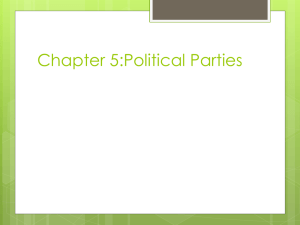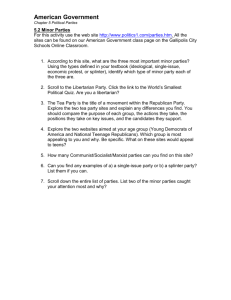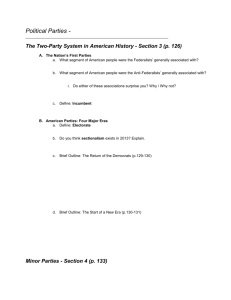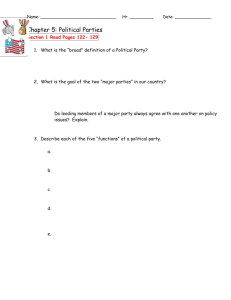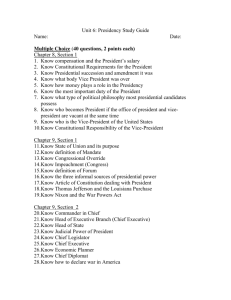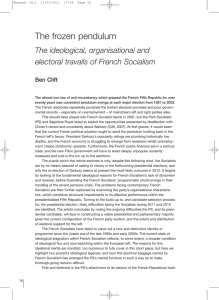Ch 5-4 The Minor Parties
advertisement
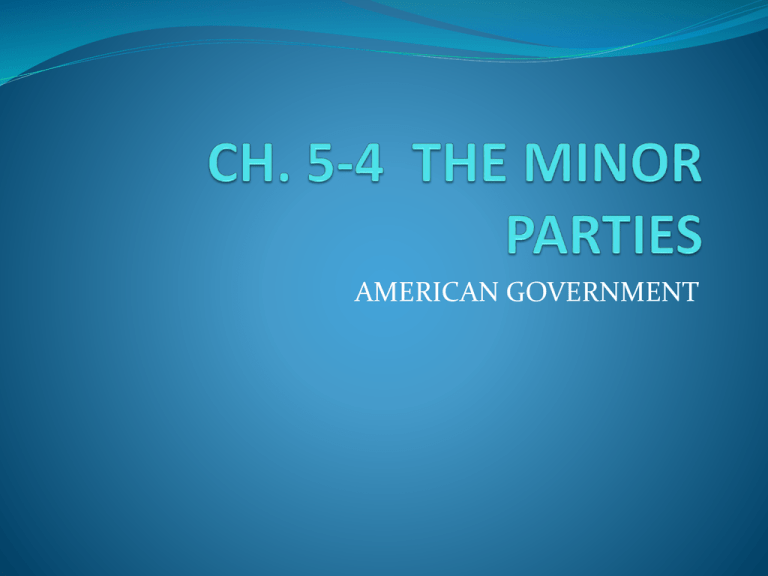
AMERICAN GOVERNMENT MINOR PARTIES IN THE UNITED STATES Their number and variety make minor parties difficult to describe and classify Some are limited to a particular locale, others to a single state, and some to one region Others have tried to gain national support Most exist around a single theme but some have a broader, more practical approach FOUR DISTINCT TYPES OF MINOR PARTIES 1) Ideological parties Based on a particular set of beliefs—a comprehensive view of social, economic, and political matters Most built on some shade of Marxist thought Examples—Socialist, Socialist Labor, Socialist Worker, and Communist Parties A few have a different approach Libertarian Party emphasizes individualism and calls for doing away with most of government’s present functions and programs Ideological parties seldom win many votes but there are usually long-lived 2) Single-Issue Parties Focus on one public-policy matter Names indicate their primary concern Example—Free Soil Party opposed the spread of slavery in 1840s & 1850s The American Party (aka The Know-nothings) opposed Irish-Catholic immigration in the 1850s Right to Life Party opposes abortion today Most single-issue parties fade into history 3) Economic Protest Parties Show up during periods of economic discontent Proclaim their disgust with major parties and demand better times Most often these are sectional parties, drawing their strength from the South and West The Greenback Party (1876-1884)—tried to take advantage of agrarian discontent They called for free coinage of silver, federal regulation of railroads, an income tax, and labor legislation Populist Party 1890s (descendant of the Greenbacks) Demanded public ownership of railroads, telephone and telegraph companies, lower tariffs Each of these parties disappeared as the nation climbed out of difficult economic times 4) Splinter Parties Parties that have split away from a larger party Most of the important minor parties have been splinter parties Among the leading groups that have split from the Republicans: “Bull Moose” Progressive Party of 1912—Theodore Roosevelt Progressive Party of 1924—Robert La Follette Groups that have split from the Democrats: Progressive Party 1948—Henry Wallace States’ Rights (Dixiecrat) Party American Independent Party 1968—George Wallace Most splinter parties form around a strong personality Most often someone who has failed to win a major party’s presidential nomination These parties fade away or collapse when the leader steps aside The Green Party 1996 points out the difficulties in classifying minor parties. The began as a classic single-issue party As the party evolved, it doesn’t fit in any of the catagories listed The Green Party came to prominence in 2000 with Ralph Nader as its presidential nominee. He campaigned on several issues: environmental protection, universal health care, gay and lesbian rights, restraints on corporate power, campaign finance reform, opposition to global free trade, etc. The Greens refused to re-nominate Nader in 2004. They went with David Cobb instead WHY MINOR PARTIES ARE IMPORTANT Most Americans do not support minor parties but they have made important contributions The Anti-Masons party first used a national convention to nominate a presidential candidate in 1831. The Whigs and Democrats followed suite in 1832 A strong third-party candidate can play a “spoiler role” The Green Party 2000 pulled votes mainly from the Democrats possibly causing Al Gore the Presidency The Presidential Election of 1912 (graphic p. 134) Had Roosevelt not quit the Republican Party, Taft would have had a better showing and Wilson would not have become President Historically, the role of minor parties has been one of critic and innovator Minor parties present ideas that the major parties have eventually taken on and called their own. (chart p. 135) The End
